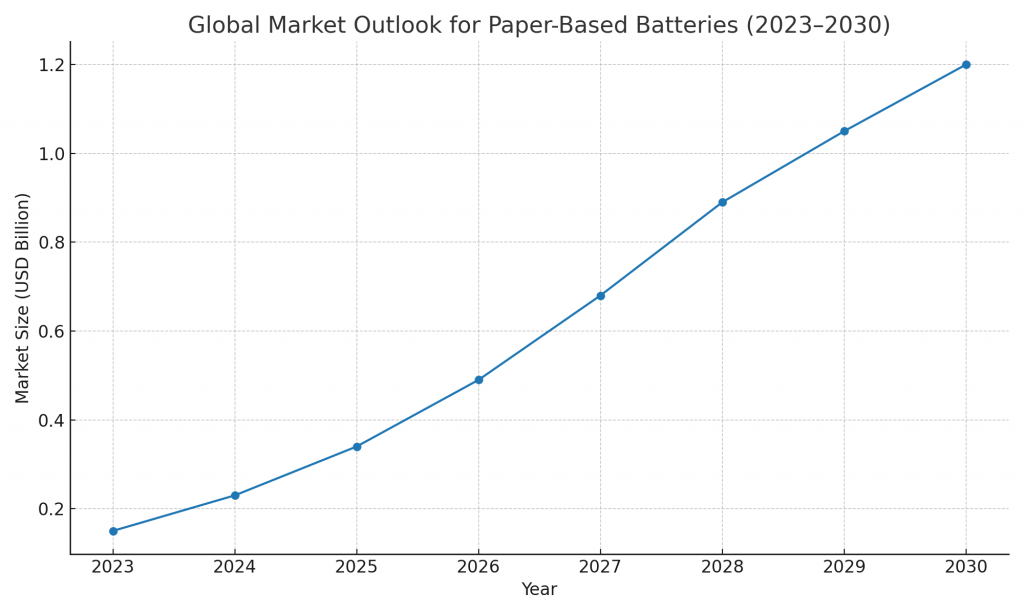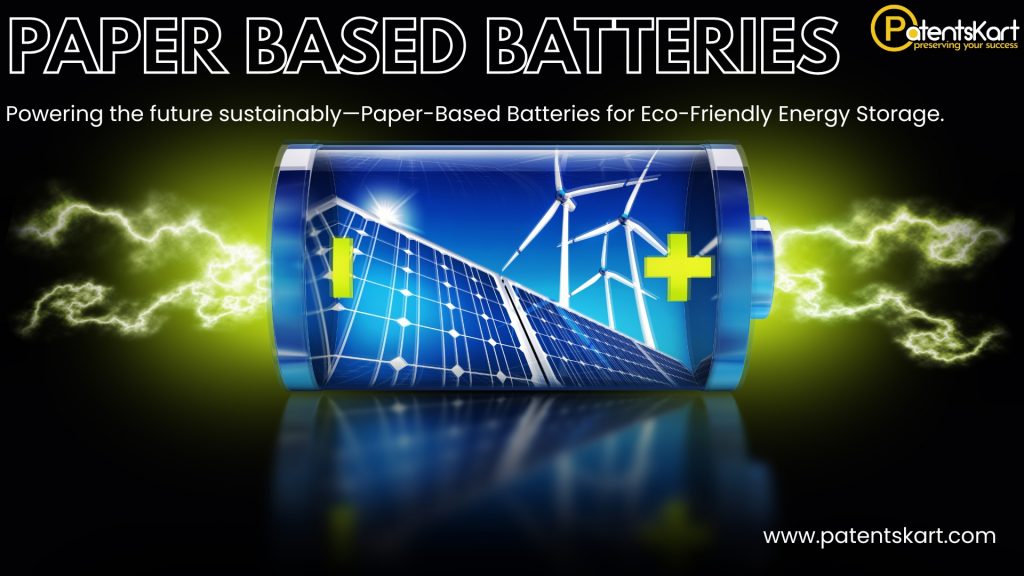Introduction
Conventional batteries have long powered the digital age, but they come at a cost: toxic materials, difficult recycling processes, and massive e-waste generation. As demand for greener, flexible, and disposable power sources grows—particularly for wearables, diagnostics, and logistics—new materials and formats are gaining traction. Among the most disruptive of these is the paper-based battery: a biodegradable, lightweight, and cost-effective innovation that may redefine portable energy in the coming decade.
This blog explores the science, commercial potential, innovation pipeline, and IP landscape surrounding paper-based batteries, and why every investor and technology decision-maker should be paying close attention in 2025.
What Are Paper-Based Batteries?
Paper-based batteries are energy storage devices built using cellulose-based paper as a functional component—typically as the electrolyte separator or structural substrate. These systems integrate conductive inks, carbon nanomaterials, metal oxides, or even bioenzymatic agents to create safe and sustainable batteries.
Unlike traditional batteries that rely on heavy metals and synthetic polymers, paper-based batteries are often entirely compostable, can be activated by water or air, and are safe for disposal in non-specialized environments. This positions them as ideal solutions for temporary or disposable applications.
Key Functional Benefits:
- Biodegradability: Designed to break down without environmental harm.
- Flexibility: Compatible with printed electronics and rollable substrates.
- Low Manufacturing Footprint: Can be fabricated using inkjet or screen-printing processes.
- Safety: No explosion or leakage risks from lithium or corrosive chemicals.
Types of Paper-Based Battery Technologies The field is evolving rapidly, with multiple architectures under development. Here’s a breakdown of key formats:
| Type | Description | Technology Readiness Level (TRL) | Example Applications |
|---|---|---|---|
| Cellulose Supercapacitors | Use carbon-coated paper layers for rapid charge/discharge cycles | Medium | Wearable sensors, skin patches |
| Zinc-Based Paper Batteries | Combine zinc anodes with conductive cellulose cathodes; often water-activated | High | Smart packaging, temperature loggers |
| Paper-Lithium Batteries | Integrate lithium salts into treated paper substrates | Low–Medium | Flexible electronic devices |
| Microbial Paper Batteries | Generate electricity through bacterial metabolism within paper substrate | Lab Stage | Environmental biosensors |
| Hybrid Systems | Use graphene, nanofibers, or enzymatic fuels combined with paper | Medium | Medical diagnostics, ingestible sensors |
Each type brings trade-offs in energy density, stability, environmental durability, and cost, depending on the target application.
Cross-Industry Applications: Where Paper Batteries Matter
Paper-based batteries are not generic power cells—they are purpose-built for edge-case, low-power, or temporary applications where conventional batteries fail.
- Smart Packaging: Power for sensors that monitor humidity, temperature, or location; used in cold-chain logistics and pharma packaging.
- Medical Diagnostics: Single-use biosensors or lateral flow assays where electronics need to degrade safely post-use.
- Wearables and Fitness: Lightweight power for flexible displays, skin-worn sensors, or patches.
- Environmental Monitoring: Deploy-and-degrade systems for field-based chemical or pollutant detection.
- Retail and Advertising: Powering interactive or illuminated labels and promotional materials.
In each case, the value is not just energy delivery, but the ability to integrate power into form factors where conventional batteries can’t go.
Patent Landscape and Innovation Leaders
The last five years have seen a surge in IP activity surrounding paper-based batteries.
- Global Growth: Over 30% CAGR in relevant patents from 2018–2024.
- Jurisdictions Dominating: U.S., Japan, South Korea, Germany, China.
- Key Themes: Enzyme-based biofuel cells, graphene-cellulose composites, water-activated printing.

Global Market Outlook and Investment Trends
The global market for paper-based batteries is expected to grow significantly as sustainability becomes central to energy and electronics strategies. While still in the early commercialization phase, industry analysts estimate the market could exceed USD 1.2 billion by 2030, growing at a CAGR of 18–22% over the next five years.

Key Drivers:
- Corporate demand for compostable components
- Government push for green electronics and low-waste diagnostics
- Cost-efficiency in logistics and retail packaging
Funding & Investment Hotspots:
- The European Union’s Horizon 2025 program is investing in flexible green energy solutions
- Y Combinator and CleanTech VCs are funding battery-material startups
- Licensing deals emerging around enzyme-based power systems and smart packaging integrations
Technology Readiness Level (TRL) Overview
Different paper-based battery types are maturing at different rates. The TRL framework helps assess their deployment timelines:
| Battery Type | TRL (1–9) | Status |
|---|---|---|
| Zinc-based paper batteries | 7–8 | Commercial pilots underway |
| Cellulose supercapacitors | 6–7 | Prototypes in field testing |
| Microbial paper batteries | 3–4 | Academic proof of concept stage |
| Lithium-paper hybrid systems | 4–5 | Lab-to-pilot transition stage |
| Enzyme-powered paper cells | 6–7 | Limited deployments in medical diagnostics |
These indicators suggest that wide-scale market readiness will begin around 2025–2027 for high-TRL formats, particularly in healthcare and logistics.
Top Companies Shaping the Sector
| Company | Country | Focus Area |
| Flint Engineering | UK | Water-activated batteries for retail logistics |
| BeFC | France | Enzymatic, compostable batteries for medical and packaging uses |
| Samsung SDI | South Korea | Graphene-enhanced flexible substrates |
| Enfucell | Finland | Printed batteries for smart labeling systems |
| Zoxcell | UAE | Supercapacitors using graphene-cellulose matrices |
| Toshiba | Japan | Foldable lithium-based paper prototypes |
| LG Energy Solution | South Korea | Green battery IP with cellulose composites |
| Skeleton Technologies + Bosch | Germany | Printed ultracapacitor systems for rapid charge applications |
| Blue Spark | USA | Thin batteries for diagnostics (now exploring biodegradable substrates) |
| Imprint Energy | USA | Zinc-based flexible battery platforms (pilot stage) |
| Stora Enso | Finland | Paper electronics in logistics and packaging |
| Xerox PARC | USA | Printed battery R&D and device integration |
| Ionic Industries | Australia | Graphene printing on compostable paper |
Leading Academic and Research Contributors
| Institution | Country | Specialty |
| Linköping University | Sweden | Organic electronics + supercapacitors |
| Stanford University | USA | Ultrathin biodegradable nanobatteries |
| IIT Madras | India | Microbial cellulose battery development |
| NTU | Singapore | Printable flexible energy devices |
| Empa (ETH Zurich) | Switzerland | Compostable power sources integration |
| University of Tokyo | Japan | Nanocellulose and thin film electrolytes |
| UC Davis | USA | Paper-based microbial fuel cell research |
| VTT | Finland | Roll-to-roll paper electronics manufacturing |
| KAIST | South Korea | Flexible supercapacitor innovation |
| Chalmers University | Sweden | Cellulose-graphene composite energy tech |
| Fraunhofer ISC | Germany | Circular design and printed battery systems |
Commercialization Outlook: 2025 and Beyond
- BeFC: Rolling out diagnostic power units using paper batteries across European healthcare by Q4 2025.
- Stora Enso + VTT: Collaborating on RFID power solutions for European retail and cold-chain by mid-2025.
- Flint Engineering: Targeting millions of paper battery units shipped annually by 2026 for logistics.
Evolving Regulatory and Testing Standards
| Body | Standard | Applicability |
| IEC | 62133 | General safety for rechargeable battery systems |
| ISO | 18606 | Compostability of packaging materials |
| ASTM | D6400 | Biodegradable plastics testing (battery casings) |
| REACH/RoHS | EU | Material safety and compliance for electronics |
Emerging guidance is also focused on performance under humidity, shelf stability, and electronic waste classification.
Challenges to Market Penetration
- Energy Density: Limits application in high-draw devices.
- Moisture Sensitivity: Needs sealed environments or rapid-use design.
- Manufacturing Complexity: Specialized printers or roll-to-roll setups needed.
- Cost Competitiveness: Economies of scale not yet achieved.
- System Integration: Still incompatible with some rigid PCBs and electronics platforms.
Investment and IP Opportunity Zones
- Patent gaps in tropical-resistant materials
- Scale-up partnerships for roll-to-roll biodegradable printing
- IP around activation triggers (e.g., pH, air, sweat)
- Strategic M&A opportunities in diagnostics, logistics, and wearable supply chains
Frequently Asked Questions (FAQ)
-
What are paper-based batteries made of?
Paper-based batteries typically use cellulose paper as the structural base, enhanced with materials like carbon nanotubes, metal oxides, or enzymatic compounds for conductivity and energy storage.
-
Are paper-based batteries biodegradable?
Yes. Most designs are fully biodegradable and compostable, making them ideal for disposable or single-use applications where environmental impact is a concern.
-
What industries will benefit most from paper-based batteries?
Industries such as medical diagnostics, smart packaging, wearables, and environmental monitoring are expected to adopt these technologies rapidly due to their low power needs and form-factor flexibility.
-
Who are the leading companies in paper-based battery innovation?
Companies like Flint Engineering, BeFC, Samsung SDI, and Enfucell are among the leaders actively developing and commercializing paper-based battery technologies.
-
How long until paper-based batteries reach mainstream adoption?
Select applications are already being commercialized, with broader adoption expected by 2026–2028 as manufacturing scales and regulatory clarity improves.
How PatentsKart Can Help
- IP Landscape Mapping for material and process innovations
- FTO and licensing support for paper-battery integration
- Deep analytics on TRL, citation strength, and commercial relevance
- Ongoing monitoring of academic-to-commercial pipeline in this space
Recent Blogs By PatentsKart
Needle-Free Injections: Powerful Shifts Revolutionizing Drug Delivery in 2025 – Patentskart
Top Digital Construction Technologies Revolutionizing the Building Industry in 2025
Conclusion
Paper-based batteries are not a novelty—they represent a decisive shift in how we think about energy storage. They are enabling a new class of eco-conscious, embedded electronics that align with sustainability goals and regulatory demands.
As commercialization accelerates, stakeholders who invest in or build around this ecosystem will gain first-mover advantage in a future where electronics must be smarter, safer, and biodegradable.
To explore more such innovations and secure your IP position in emerging tech, visit www.patentskart.com or reach out to us at info@patentskart.com.







